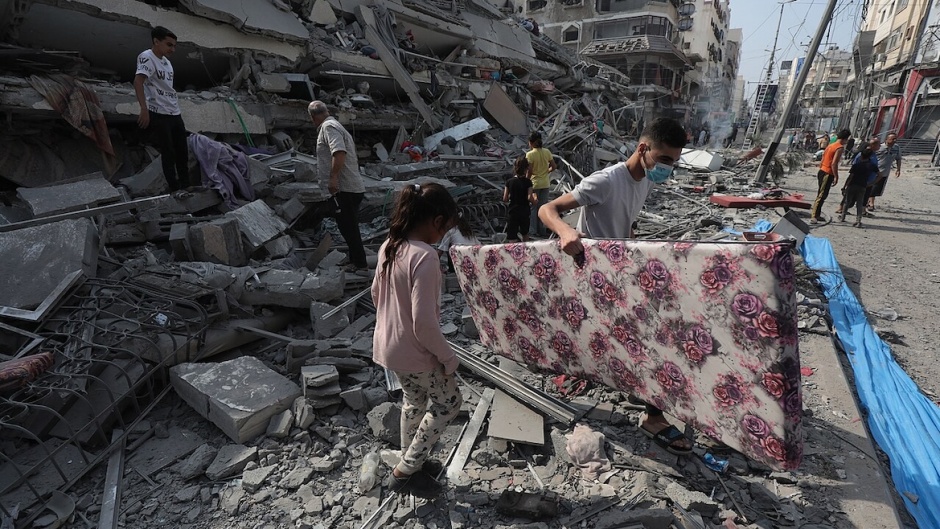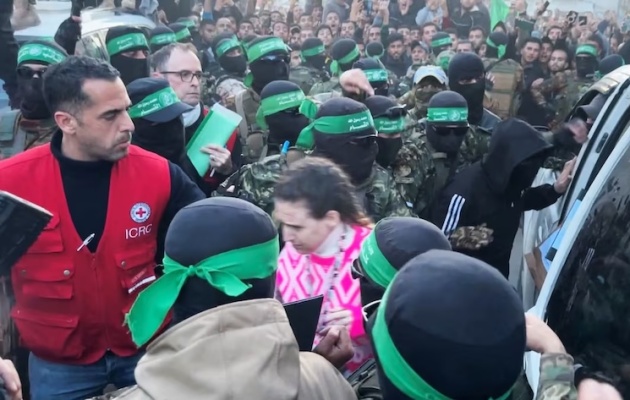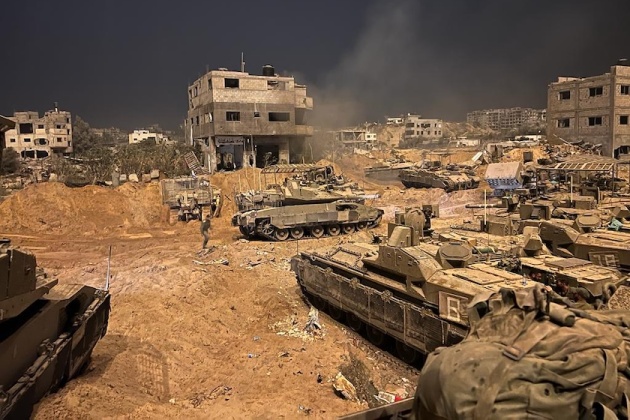The development of the ceasefire between Hamas and Israel opens the debate on what steps could be taken to find a solution to a conflict that is always on the verge of exploding.
 A residential building in Gaza, hit by Israeli shelling, October 2023./ Palestinian News & Information Agency (Wafa), Wikipedia.
A residential building in Gaza, hit by Israeli shelling, October 2023./ Palestinian News & Information Agency (Wafa), Wikipedia.
Following the ceasefire in Gaza, there are meetings of several world leaders to discuss the future of a territory that has undergone over a year of destruction by Israeli military action against the Hamas terrorist group.
The current conflict was triggered by Hamas' aggression on Israeli territory on 7 October 2023.
Donald Trump's words, describing Gaza as a “demolition site” and acknowledging that it is “not habitable”, were followed by a proposal for reconstruction that would involve the temporary displacement of the population. The Arab countries and several international bodies have said they disagreed with this idea.
The first phase of the ceasefire agreed in January is currently underway, under which Hamas pledged the release of 33 hostages in exchange for nearly 1,000 Palestinian prisoners, a partial Israeli withdrawal from the Gaza Strip and a significant increase in humanitarian aid.
The deadline for implementing the agreement is the first week of March.
Although there is no firm timeline set, the phase 2 of the agreement would involve the release of the remaining Israeli hostages (around 70) as well as the release of more Palestinian prisoners, and a full Israeli withdrawal with a formal declaration of the end of the war.
The scenario of the conflict is volatile, and the unknowns about Gaza's future will remain until a final agreement is reached.
The goal of Netanyahu involves “eliminating Hamas's military capability and its political rule in Gaza”, an aim for which he has the support of the US.
There has also been criticism of Hamas from the Arab side in recent weeks, including the secretary general of the Arab League, Ahmed Aboul Gheit, who urged the terrorist organisation to give up control of the Gaza Strip.
“The interests of the Palestinian people must come before those of the (Hamas) movement”, said Anwar Gargash, a senior diplomatic adviser to UAE President Mohammed bin Zayed.

[photo_footer]The ceasefire agreement involves the gradual release of 33 hostages. / El País from YouTube[/photo_footer]
In recent days, the ceasefire has almost collapsed due to the verbal escalation between the Israeli government and the different actors involved in the negotiation, which has been boosted by the arrival of the new administration in the White House.
In a cascade of rather confusing declarations, Donald Trump's proposal implied a displacement of the current population in Gaza to Egypt and Jordan so that the US could undertake the reconstruction.
Both Egypt and Jordan expressed their opposition to this displacement. For the Office of the High Commissioner for Human Rights, “it is manifestly illegal to invade and annex foreign territory by force, to forcibly deport its population”,
However, the US administration insists on Trump's idea and the US Secretary of State, Marco Rubio, during his visit to Israel on Sunday, expressed his interest in knowing "if these (critical) countries have any better plan", relying once again on the mobilisation of the Gazan population.
Trump's proposal also fails to clarify the legal status of the territory in question.
The Palestinian National Authority presented a proposal that calls for a two-state solution, an alternative supported by a large part of the international community and the UN, which has not been developed so far, despite multiple attempts by international diplomacy.
“The ceasefire is long overdue, considering that it is the same agreement offered to Israel and agreed by Hamas a year earlier”, says Daoud Kuttab, a Palestinian Christian journalist and member of the Amman Baptist Church speaking to Spanish news website Protestante Digital.
“If it had been accepted, many lives on both sides could have been saved”, he adds.
The Israel-Hamas war has so far left 1139 people dead in Israel in the 7 October attack and 405 Israeli soldiers in the operations in Gaza. According to Hamas, by 23 January 2025, the death toll in Gaza is 47,283 people, the vast majority of them civilians.
According to Kuttab, Trump's concern for the future of Gazans is “not genuine”, since it is expressed while “he stood in front of Israeli flags and Israeli leader wanted for war crimes” (referring to Netanyahu).
However, there is “a remote possibility” that the conflict could find a solution “if Trump is willing to engage the US military to achieve a separation between the occupier and the occupied in a way that Israelis and Palestinians can feel safe and dignified”, including in this agreement “the West Bank as well”.

[photo_footer]The Israeli army, displaced in Gaza, has been carrying out military operations for 15 months. / FDI, Wikipedia.[/photo_footer]
Kairos Palestine, a group of Palestinian Christian peace activists, have been highly critical of Trump's proposal, considering it a “neo-colonialist” approach.
They also denounce the increase in clashes and Israeli military actions in the West Bank once the focus of the news is on Gaza.
Daoud Kuttab believes that Christians “must heed the beatitudes and seek peace”, following “the call of the prophet Amos [in the Bible] and insist that justice must flow like a river”.
“Christians must remember that Palestinians, like Israelis, are created in the image of God, and that Palestinian Christians have suffered death and suffering at the hands of Israelis alongside their fellow Palestinian Muslims”, he points out.
Kuttab believes that “no one should use Christian theology to justify the killing of human beings and the carrying out of injustice”.
Another voice from Israel, Jonathan Feldstein, president in Israel of the Genesis 123 Foundation, advocates for direct Christian involvement in mediation and reconstruction work.
This foundation recently presented a ‘Peace for Gaza’ plan that starts with the elimination of Hamas, so that the reconstruction aid that might reach the country would not be used “to strengthen its infrastructure”.
Feldstein believes it would take “an army” of Christians to restore everything. “Engineers, architects, and city planners. medical personnel, nutritionists, educators, and people with backgrounds that can rebuild and create prosperity”.
His hope is that “Christians will succeed because they love Gazans and want to see them prosper, and reject the evil Islam represented by Hamas and Iran”.
Feldstein, who identifies as an Orthodox Jew, believes that Christians can be the solution to a problem “that requires bringing a fresh approach, not the same ideas that have failed time and again in the past”, he says, referring to the two-state solution.
“Islamists like Hamas and their Iranian supporters who embody that ideology seek the annihilation of Israel, not to live alongside it”, underlines in an article published in online newspaper AllIsrael.
“The solution is to counteract that, to reverse the failures that extremist Islam has caused in Gaza”, something that can only change “when there is a real change in the hearts of the people”, concluded Feldstein.
[analysis]
[title]Join us to make EF sustainable[/title]
[photo][/photo]
[text]At Evangelical Focus, we have a sustainability challenge ahead. We invite you to join those across Europe and beyond who are committed with our mission. Together, we will ensure the continuity of Evangelical Focus and Protestante Digital (Spanish) in 2025.
Learn all about our #OneMoreYearEF campaign here (English).
[/text][/analysis]

Las opiniones vertidas por nuestros colaboradores se realizan a nivel personal, pudiendo coincidir o no con la postura de la dirección de Protestante Digital.
Si quieres comentar o